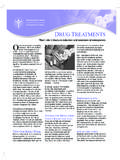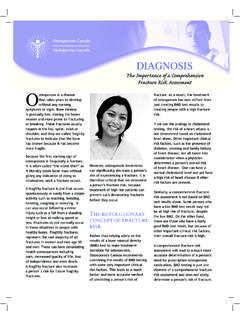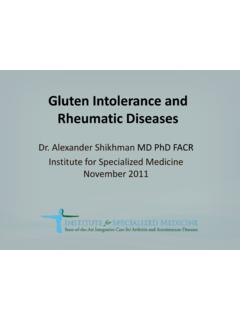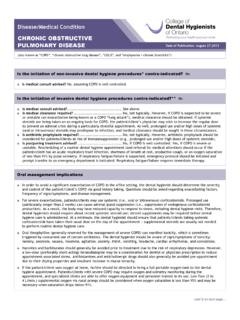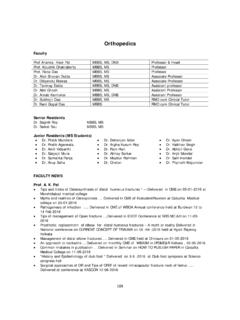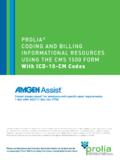Transcription of Bisphosphonates for treatment of osteoporosis
1 324 Canadian Family Physician Le M decin de famille canadien | VOL 60: APRIL AVRIL 2014 Clinical ReviewBisphosphonates for treatment of osteoporosisExpected benefits, potential harms, and drug holidaysJacques P. Brown MD Suzanne Morin MD MSc William Leslie MD Alexandra Papaioannou MD Angela M. Cheung MD PhD Kenneth S. Davison PhD David Goltzman MD David Arthur Hanley MD Anthony Hodsman MD Robert Josse MD Algis Jovaisas MD Angela Juby MD Stephanie Kaiser MD Andrew Karaplis MD David Kendler MD Aliya Khan MD Daniel Ngui MD Wojciech Olszynski MD PhD Louis-Georges Ste-Marie MD Jonathan Adachi MDAbstractObjective To outline the efficacy and risks of bisphosphonate therapy for the management of osteoporosis and describe which patients might be eligible for bisphosphonate drug holiday.
2 Quality of evidence MEDLINE (PubMed, through December 31, 2012) was used to identify relevant publications for inclusion. Most of the evidence cited is level II evidence (non-randomized, cohort, and other comparisons trials).Main message The antifracture efficacy of approved first-line Bisphosphonates has been proven in randomized controlled clinical trials. However, with more extensive and prolonged clinical use of Bisphosphonates , associations have been reported between their administration and the occurrence of rare, but serious, adverse events. Osteonecrosis of the jaw and atypical subtrochanteric and diaphyseal femur fractures might be related to the use of Bisphosphonates in osteoporosis , but they are exceedingly rare and they often occur with other comorbidities or concomitant medication use. Drug holidays should only be considered in low-risk patients and in select patients at moderate risk of fracture after 3 to 5 years of When Bisphosphonates are prescribed to patients at high risk of fracture, their antifracture benefits considerably outweigh their potential for harm.
3 For patients taking Bisphosphonates for 3 to 5 years, reassess the need for ongoing osteoporosis is characterized by accelerated loss of bone mass and deterioration of bone architecture, leading to increased frac-ture Osteoporotic fractures decrease personal independence,2 increase morbidity,3-5 and shorten life6,7; thus, their prevention is (alendronate, risedro-nate, and zoledronic acid) are first-line therapies for the prevention of fracture in high-risk Aminobisphosphonates might also increase survival in ways at least partially independent of their contri-bution to decrease in fracture While the antifracture efficacy and relative safety of the ami-nobisphosphonates have been well established in clinical trials,12-16 there have been concerns that pro-longed use of these drugs might increase the risk of rare, but serious, adverse vignetteYour 71-year-old patient, Mrs Jones, saw you today to review her bone mineral density (BMD) report.
4 She has been well and compliant with alendronate (70 mg once a week), in addition to vitamin D (1000 IU/d) and adequate dietary calcium intake, for the past 6 years. However, her friends have told her EDITOR S KEY POINTS The absolute risk of bisphosphonate-associated atypical subtrochanteric and diaphyseal femur fracture is between 2 and 78 cases per 100 000 person-years. The absolute risk of bisphosphonate-associated osteonecrosis of the jaw is approximately 1 case per 100 000 person-years when Bisphosphonates are administered for osteoporosis treatment . Bisphosphonate drug holidays can be considered for patients who have persisted with bisphosphonate therapy for 3 to 5 years and for those at low risk of fracture. High-risk patients with osteoporotic bone mineral density or history of fragility fracture (including prevalent vertebral fracture) are not candidates for bisphosphonate article is eligible for Mainpro-M1 credits.
5 To earn credits, go to and click on the Mainpro link. This article has been peer reviewed. Can Fam Physician 2014;60 traduction en fran ais de cet article se trouve dans la table des mati res du num ro d avril 2014 la page 60: APRIL AVRIL 2014 | Canadian Family Physician Le M decin de famille canadien 325 Bisphosphonates for treatment of osteoporosis | Clinical Reviewthat she should discuss stopping her bisphosphonate therapy with you because she has been taking it long enough and it might cause her serious harm. She sought your reviewing her file, you noted that you first ordered a BMD measurement when she was 65 years old in order to assess her fracture risk. At that time, her BMD T-score was at the lumbar spine and at the femoral neck. She had never sustained a fragility fracture nor used glucocorticoids.
6 She was healthy, except for hypertension, which she con-trolled by taking ramipril and hydrochlorothiazide. She had never smoked, only consumed alcohol occa-sionally, and had no family history of osteoporosis or fractures. On examination, you determined she had lost as much as 5 cm in height since she was 25 years old. Five years ago, her 10-year absolute risk of fracture was defined as moderate according to the current osteoporosis Canada guidelines (10% to 20% probability of a major osteoporotic fracture). You decided to order a lateral spine x-ray scan to rule out vertebral The radiology report confirmed grade 2 (25% to 40% reduction in vertebral height) compression fractures in the thoracic vertebrae T10 and T11, moving her into the high-fracture-risk cat-egory.
7 After discussion, you had initiated weekly alen-dronate along with supplemental calcium and vitamin D. Since then, she has not suffered any recurrent frac-tures and has been taking an appropriate dose, has tolerated the medication well, and has had no further height loss. She also started a walking program 3 times per of evidenceMEDLINE (PubMed) was searched using combinations of the key words alendronate, risedronic acid, zoledronic acid, etidronic acid, bisphosphonate-associated osteonecrosis of the jaw, atrial fibrillation, esophageal neoplasms, renal insuf-ficiency, chronic, atypical, femoral fracture, drug holiday, and discontinuation, for all dates to December 31, 2012. The search was limited to human studies published in English. Additional relevant investigations were gathered from the reference sections of reviewed articles and from survey-ing Canadian osteoporosis experts.
8 Abstracts from the American Society for Bone and Mineral Research annual meetings for the years 2008 to 2012 were also searched for relevant investigations. Relevant studies addressing the pri-mary questions were retained and reviewed for inclusion. The level of evidence was primarily level II, and to a lesser extent level I, as most publications were observational stud-ies or case reports (Table 1).Main messageUnique characteristics of aminobisphosphonates. Bisphosphonates , potent inhibitors of osteoclast-mediated bone remodeling, bind to bone and have prolonged res-idence in the skeleton. Bisphosphonates can remain bound to bone for many years; those with greater bind-ing affinities (zoledronic acid > alendronate > ibandro-nate > risedronate > etidronate) possess longer skeletal Consequently, after bisphosphonate discon-tinuation, bound bisphosphonate provides residual phar-macologic action for many years,23,24 in contrast to other antiresorptive therapies in which activity is quickly lost after discontinuation (ie, denosumab, estrogen, raloxi-fene, and calcitonin).
9 25-27 Safety of long-term bisphosphonate use. As osteo-porosis is a chronic disease, antifracture therapy could conceivably continue for the rest of a patient s life. While there are non-bisphosphonate therapies available to decrease fracture risk in high-risk individuals, many, other than denosumab, do not have evidence of effi-cacy comparable to that for the aminobisphosphonates at vertebral, nonvertebral, and hip sites. Unfortunately, there are few data to guide use of any osteoporosis ther-apy for more than 3 to 5 phase 3 trials for Bisphosphonates assessed rela-tively small patient populations (1000 to 8000 patients) for short durations (usually 3 years) and excluded up to 80% of patients who might seek osteoporosis ther-apy in actual clinical Postmarketing reports based upon millions of patient-years29 and long-term (longer than 5 years) clinical administration have sug-gested associations between some previously unknown, rare adverse events and bisphosphonate use including osteonecrosis of the jaw (ONJ), atypical subtrochanteric and diaphyseal femur fractures (AFF), atrial fibrillation (AF), and esophageal of the jaw.
10 Osteonecrosis of the jaw is defined as the presence of exposed bone in the max-illofacial region that does not heal within 8 weeks of identification by a health care provider, in the absence of radiation Osteonecrosis of the jaw is not just jaw pain and is easily assessed with conservative measures. At the present time, evidence suggests that there is a dose-response relationship between bisphos-phonate use and the development of While Table 1. Literature grading scaleLEVELS OF EVIDENCETRIAL DESIGNSL evel IAt least 1 properly conducted randomized controlled trial, systematic review, or meta-analysisLevel IIOther comparison trials; non-randomized, cohort, case-control, or epidemiologic studies; and preferably more than 1 studyLevel IIIE xpert opinion or consensus statements326 Canadian Family Physician Le M decin de famille canadien | VOL 60: APRIL AVRIL 2014 Clinical Review | Bisphosphonates for treatment of osteoporosisthe current consensus accepts a causal relationship between bisphosphonate exposure and ONJ, the patho-logic mechanism or mechanisms have yet to be eluci-dated.
